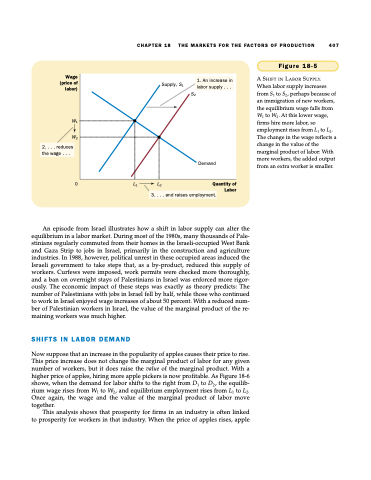Page 399 - The Principle of Economics
P. 399
CHAPTER 18 THE MARKETS FOR THE FACTORS OF PRODUCTION 407
Supply, S1
S2
Demand
1. An increase in labor supply . . .
Wage (price of labor)
W1 W2
0 L1 L2
Figure 18-5
A SHIFT IN LABOR SUPPLY. When labor supply increases from S1 to S2, perhaps because of an immigration of new workers, the equilibrium wage falls from W1 to W2. At this lower wage, firms hire more labor, so employment rises from L1 to L2. The change in the wage reflects a change in the value of the marginal product of labor: With more workers, the added output from an extra worker is smaller.
2. . . . reduces the wage . . .
3. . . . and raises employment.
Quantity of Labor
An episode from Israel illustrates how a shift in labor supply can alter the equilibrium in a labor market. During most of the 1980s, many thousands of Pale- stinians regularly commuted from their homes in the Israeli-occupied West Bank and Gaza Strip to jobs in Israel, primarily in the construction and agriculture industries. In 1988, however, political unrest in these occupied areas induced the Israeli government to take steps that, as a by-product, reduced this supply of workers. Curfews were imposed, work permits were checked more thoroughly, and a ban on overnight stays of Palestinians in Israel was enforced more rigor- ously. The economic impact of these steps was exactly as theory predicts: The number of Palestinians with jobs in Israel fell by half, while those who continued to work in Israel enjoyed wage increases of about 50 percent. With a reduced num- ber of Palestinian workers in Israel, the value of the marginal product of the re- maining workers was much higher.
SHIFTS IN LABOR DEMAND
Now suppose that an increase in the popularity of apples causes their price to rise. This price increase does not change the marginal product of labor for any given number of workers, but it does raise the value of the marginal product. With a higher price of apples, hiring more apple pickers is now profitable. As Figure 18-6 shows, when the demand for labor shifts to the right from D1 to D2, the equilib- rium wage rises from W1 to W2, and equilibrium employment rises from L1 to L2. Once again, the wage and the value of the marginal product of labor move together.
This analysis shows that prosperity for firms in an industry is often linked to prosperity for workers in that industry. When the price of apples rises, apple


